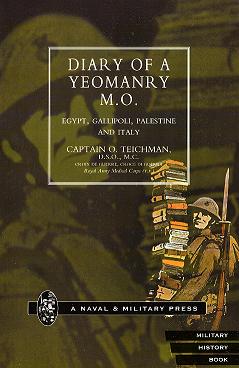The Diary of a Yeomanry M.O.
 Published by T. Fisher Unwin Ltd London: Adelphi Terrace
Published by T. Fisher Unwin Ltd London: Adelphi Terrace
Published 1921
Throughout the late war, the author of this book kept a diary, often under considerable
difficulties and on odd scraps of paper, owing to the order which forbade the taking of
diaries into the front line: occasionally these had to be written in cipher or destroyed
when there seemed a possibility of the writer being captured. Apology is made for the
apparently trivial incidents of the daily routine during the quiet periods, which are
retained in the text in order to make the narrative continuous. Owing to the first year's
diary having been lost, this period, which contained little of interest, has been covered
by a brief synopsis. The narrative does not pretend to be in any way a full or accurate
account of current events, being merely the experiences of the writer and his deductions,
the latter often proving erroneous when subsequent facts became known at a later date. If
it should prove of some slight interest to those members of Mounted Units and Medical
Officers who took part in the campaign, the time spent daily in compiling it will not have
been in vain. A chapter has been added on the last phase of the war in Italy, where the
writer had the good fortune to accompany the Twenty-second Infantry Brigade which captured
the Island of Papadopoli (Piave). Acknowledgment is made to the official Dispatches, official
intelligence, and to extracts and maps from The Times (Weekly Edition).
The author, a Territorial medical officer in the RAMC, was attached to the Worcestershire Yeomanry (Queen's Own Worcestershire Hussars) in 1914. The regiment was part of the 1st South Midland Brigade, 1st Mounted Division, but within a month of the outbreak of war a 2nd Mounted Division was formed and the 1st South Midland Brigade joined it. In April 1915 the division went to Egypt and in May the brigades were numbered as Mounted Brigades with 1st South Midland becoming 1st Mounted Brigade.
In August 1915 the division was ordered to proceed, dismounted, to Gallipoli and Teichman went with his regiment and into action. The division suffered heavy losses at Scimitar Hill (21st August) and this attack is described in some detail. A week later, on Chocolate Hill, Suvla, he was wounded by shrapnel and evacuated home. In one entry he describes how a large packet of maps (in very short supply) delivered to brigade HQ turned out to be maps of Cromer, Sheringham and King's Lynn districts where they had been stationed in 1914.
He rejoined his regiment at Mudros in early November from where they returned to Egypt to the Canal zone, but at christmas Teichman went down with enteric fever and was again evacuated to the UK. By May he was back at duty (his brigade had been renumbered 5th) and during operations in the Sinai Desert was again wounded, at the battle of Qatia (5th August 1916) which kept him out of action till the end of October. The diarist takes us through the rest of the Sinai campaign and, in March 1917, into Palestine, first with Murray (battles of Gaza) and then, from June 1917, with Allenby, fighting as part of the Australian Mounted Division. At Huj, on 8th November, he rode close behind his regiment as it took part in a charge against some 2,000 Turkish infantry who were protecting guns manned by Austrians and Germans; the infantry retreated and the guns were taken. The marvellous descriptions of living and fighting in the desert include an incident involving a ten foot black mamba and attempts to kill it using chloroform (corps HQ had asked for dead but undamaged snakes for antidotes to snakebites). He left the Middle East in June 1918 for leave in the UK after which he was posted to Italy where he joined 22nd Brigade (7th Division) in October for the last month of the war.
Teichman ended the war with a DSO, MC, Croix de Guerre, Croci di Guerra and three mentions in despatches. This is a well-written book by one who knows his military history - a most informative account of war in the desert.
A re-print of this book is available from:
Softback: ISBN 1843422573 or Hardback: ISBN
1847341683
Naval & Military Press
Unit 10, Ridgewood Industrial Park
Uckfield
East Sussex
TN22 5QE
United Kingdom
Telephone: 01825 749494
